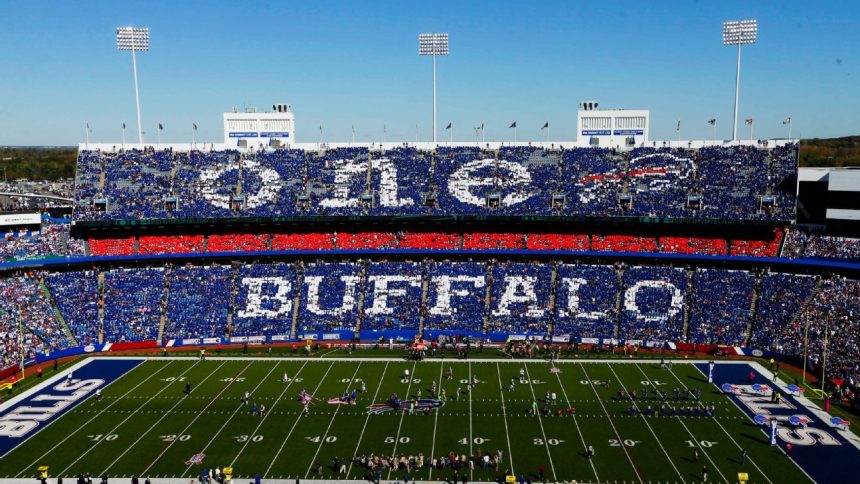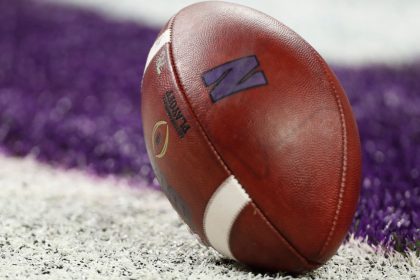
ORCHARD PARK, N.Y. — FRONT LOADERS WITH “Union Concrete Construction” stamped on the side set a barrier in a lot alongside a big stage in Orchard Park, New York. Gold shovels with Bills logos stand near a pile of dirt, waiting to be moved from one spot in the pile to the next. In the distance, Highmark Stadium, the current home of the Buffalo Bills, looms over the proceedings.
NFL commissioner Roger Goodell, New York governor Kathy Hochul — who are both Western New York natives — Erie County executive Mark Poloncarz and Bills EVP/COO Ron Raccuia arrive on stage, along with Bills coach Sean McDermott and general manager Brandon Beane.
As the ceremony begins on the first Monday in June, there’s an energy in the crowd. The group is on hand to put a formal stamp on what has been in the works for years: A new stadium for the Bills. Work on the new venue, behind the stage, has already begun. It is projected to open in 2026.
“This is one of the highlights of my time as your governor to make sure we delivered what I said we would do,” Hochul says in front of a crowd of a few hundred media members, state officials, former players and Bills staffers. “We’re keeping the Buffalo Bills in Buffalo for at least another generation, and we’re giving them a magnificent home to call their own.”
The Buffalo Bills, the heart and soul of a city known for its heart and soul, said they wouldn’t be able to stay in Western New York without a new stadium. In 2021, a spokesman said the city and state would have to decide if it wants a team or not.
The city answered yes, and now the first steps in bringing the Bills’ new home to life are coming into focus.
So how did the team secure a historic haul — a 30-year lease and a pledge of $850 million, which was at the time the largest public contribution for an NFL facility ever — to stay in the NFL’s second-smallest market?
Let’s take a closer look.
Why the need for a new stadium in the first place?
Highmark Stadium (originally called Rich Stadium) has been the home of the Bills since 1973, making it the fourth-oldest active stadium in the NFL. As far back as 2011, when the Bills were owned by Ralph Wilson Jr., the organization has explored the possibility of building a new stadium. Those explorations accelerated after the Wilson trust sold the team to the Pegulas in 2014.
“As much as we love [Highmark Stadium], and we’ve had unbelievable experiences there, it’s nearing its end of its useful life,” Raccuia told ESPN. “And we knew that and so we had to act.”
According to Poloncarz, the county expected to have conversations about the possible renovations for the current stadium in 2020, but the COVID-19 pandemic put a halt to those discussions. With the lease — which became official in 2013 before Terry and Kim Pegula bought the team — set to expire in July 2023, a decision had to be made.
At minimum the upper deck seating panels at Highmark Stadium would need replacing over the next five to seven years, according to a condition study report commissioned by Erie County in conjunction with DiDonato Engineering & Architectural Professionals in May 2021. According to Raccuia, the Pegulas estimated that it could cost “near a $1 billion” to renovate the existing structure, including $500 million to fix the upper deck alone.
In August 2021, following New York Gov. Andrew Cuomo’s resignation after sexual harassment allegations, Lt. Gov. Hochul, a Buffalo native, becomes governor. Cuomo had reservations about funneling tax dollars towards a new stadium; Hochul had no such reservations.
In March 2022, the Hochul administration, Erie County and the Bills agreed to the financing of a new Bills stadium.
In April 2023, officials signed the new stadium agreement, sending completed documents to the Erie County legislature, which approved them the next month, leading to the official groundbreaking in June.
How much will this stadium cost and who will finance it?
The new stadium price is $1.54 billion, with the Bills and New York state agreeing to a plan to extend the current lease until construction on the new stadium is complete. All parties agreed on a 30-year lease and a pledge of $850 million.
A substantial part of the Bills’ final agreement with the county and state is the community benefits agreement, which includes the team investing at least $3 million a year in the community with that amount adjusted every year. That would raise over $100 million during the terms of the lease. The Bills can decide where that money goes, but a community benefits oversight committee will be created to “identify community vulnerabilities and priorities” where the resources can best be sent. Money counted under this agreement can come from a variety of directions, including the team and the Pegulas.
Outside of the annual financial contribution, the agreement with the state includes building a public transportation hub near the new stadium and working with the Niagara Frontier Transportation Authority (NFTA) to include one or more bus or rail stops within walking distance, as well as the addition of one or more new bus routes and shuttles (including free workforce shuttles). Other language in the agreement targets minority and female-owned businesses, promoting “living wage” standards for employment practices once in operation.
Of specific note, on March 28, 2022, the same day a proposal for a stadium was approved at the NFL owners’ meetings, Seneca Nation, a local Native American tribe, approved more than $560 million of back payments to the state from casino slot revenue. The tribe lost an arbitration battle over its contention that it shouldn’t have to pay the state. Hochul allocated more than $418 million from the Seneca funds toward the state’s $600 million responsibility for the stadium.
The payments stemmed from a 14-year gaming compact that went into effect December 2002. Seneca Nation agreed to pay the state a percentage of net slot revenue in exchange for exclusive operation of three casinos in Western New York. When the first 14 years were up, Seneca Nation claimed that there was no mention of required additional payments during the renewal period.
The state disagreed.
The case went to arbitration in September 2017, and a three-person panel voted 2-1 in favor of the state in January 2019. Now Seneca Nation would be required to make payments beyond Year 14. After years of appeals, Seneca Nation announced in January 2022 that it will pay the money. The state asked for the money by March 16. When it didn’t arrive, the state, under Hochul, froze Seneca’s bank accounts.
In a late 2022 statement to ESPN, Seneca Nation president Rickey Armstrong Sr. said that the tribe has long fought for sovereignty and fair treatment. Armstrong said that will not change. But with the current agreement between Seneca Nation and the state set to expire in December 2023, the tribe wants to focus on the negotiations for a new agreement.
“In terms of what happened in the spring, do we think it was wrong and that it never should have happened? Yes, absolutely. We’ll never forget that,” Armstrong’s statement said in part. “For us, it wasn’t about a stadium, it was about the treatment of our Nation and our people as if we didn’t matter.”
In a published statement issued March 29, 2022, Hochul reiterated her stance, saying in part “these funds were generated in Western New York … This will ensure the Bills remain in New York State and support 10,000 construction jobs. The remainder of the funds will go directly to the counties and cities of Western New York.”
What are the expected economic impacts of the new stadium?
A 2021 study by Empire State Development, a group promoting business development in New York, estimated that the Bills generate approximately $27 million a year in fiscal revenues, including about $19 million from personal income taxes
However, many state legislators were not convinced by the argument that a new Bills stadium would have a net positive economic impact, pointing to a lack of evidence of long-term jobs. They also note the limited possibilities for using the stadium outside of Bills games, given the difficulty of booking ahead and a restricted calendar due to severe winters.
“There’s just been a consistent debunking of claims that building these stadiums have economic benefits,” New York State Assembly Member Zohran K. Mamdani said.
“Yet when we were listening to the governor speak about this, again and again, we were hearing the same arguments that you could have heard in 1996 or in 2011, which is that the stadium will pay for itself. This will be money that will be spent by individuals that otherwise would not have been spent. There’s going to be an uptick in employment.
“All of these kinds of things that actually when you look at the facts and the figures, you’re seeing that this is not the case.”
How serious were the rumors of the Bills leaving Buffalo?
Several landing spots were rumored. In the time after the lease was signed in 2013, three NFL teams moved to larger markets — the Los Angeles Chargers, the Los Angeles Rams and the Las Vegas Raiders.
“As much as everybody would like to think the Bills were never moving, there was always a risk being a small market and larger markets that were interested in the team,” Poloncarz said in April 2023.
Hochul, who said in April 2022 the Bills had been “reached out” to by other cities, mentioned San Diego. The Chargers, who had played in San Diego since 1961, announced their relocation to Los Angeles in January 2017, after a new downtown stadium was voted down. SoFi Stadium in Inglewood, home of the Chargers and Rams, was entirely privately funded ahead of its September 2020 opening.
“I’m sure you’re aware of the 20-year saga with the Chargers,” Rachel Laing, director of communications for the office of San Diego mayor Todd Gloria, said in an email to ESPN. “If we wouldn’t build a publicly funded stadium for them, we surely wouldn’t do it for a new team.”
Laing said that not only did San Diego not attempt to get the Bills to move west, the city didn’t even contemplate it during the current mayoral administration, in place since December 2020.
The refrain was a similar one related to other cities.
Toronto is just 98 miles from Buffalo. And Rogers Communications, which has part ownership of all Toronto’s professional teams, attempted to buy the Bills in 2014, along with rock legend Jon Bon Jovi.
“I actually think they would have moved if the Rogers Communication folks had purchased the team,” Poloncarz said. But Buffalo’s more populous neighbor was not a “realistic possibility” in any recent relocation effort, the Erie County executive added. Representatives for Toronto did not respond to a request for comment.
San Antonio has an XFL franchise, and the arrival of that team was negotiated by former Bills executive Russ Brandon, who is now that league’s president. After consulting with the general manager of the Alamodome, the 64,000-seat stadium where the San Antonio Brahmas play, a spokesman for the city of San Antonio emailed: “We have received no outreaches from the Buffalo Bills organization.”
Neither did Austin. City council member Jose “Chito” Vela has been involved with Austin politics for nearly two decades. He said that he has never had a conversation about the possibility of an NFL team in Austin. Vela added that the city, which doesn’t have the benefit of an income tax, is trying to fund essential services first.
“The city of Austin ain’t gonna put $850 million on a new stadium,” he said.
What are the chances the Bills will leave in the near future?
When the deal was announced as officially completed in early April 2023, the documents included a non-relocation agreement that has language permitting the team from even considering a move. Specifically it says that the Bills shall not “entertain any offer or proposal to relocate the Team to a location other than the Stadium.” If the Pegulas were to sell the team, the non-relocation agreement would apply to any new ownership.
It also states in the document that if the team did try to leave Buffalo before the lease is up, the county or state could sue. While it is not impossible for the Bills to move based on the agreement, it is difficult and Poloncarz said that it should be the biggest takeaway from pages and pages of documentation.
“The Buffalo Bills will be staying here, not only for the next few years during construction, but 30 years thereafter, so this lease secures them in our community until 2055,” Poloncarz said.
What will be the name of the new stadium and how will it look?
The future 63,000-plus seat stadium will feature a canopy that will cover 65% of the seats and protect against wind and precipitation. Additionally, the stadium will have a perforated multidimensional exterior skin that will prevent swirling winds from getting to the field level. The construction of the new stadium will also have concourses that are enclosed, protecting fans from the elements as they walk around the facility.
Despite the delay in the documents being finalized and approved, the stadium is expected to open on time. (The lease on the existing stadium was extended to 2028 to protect against any issues that could arise.)
The new venue will continue the name of Highmark Stadium.













